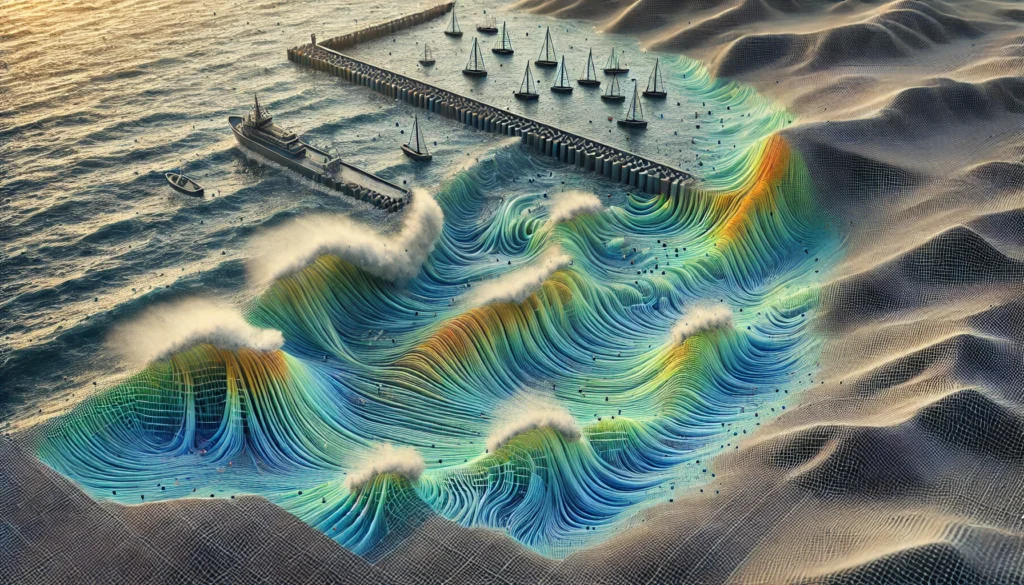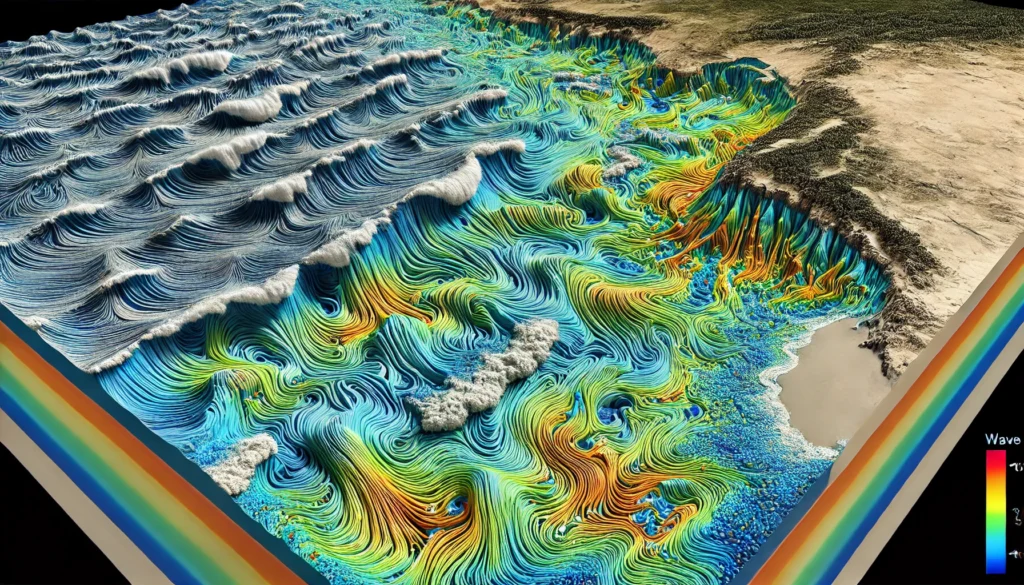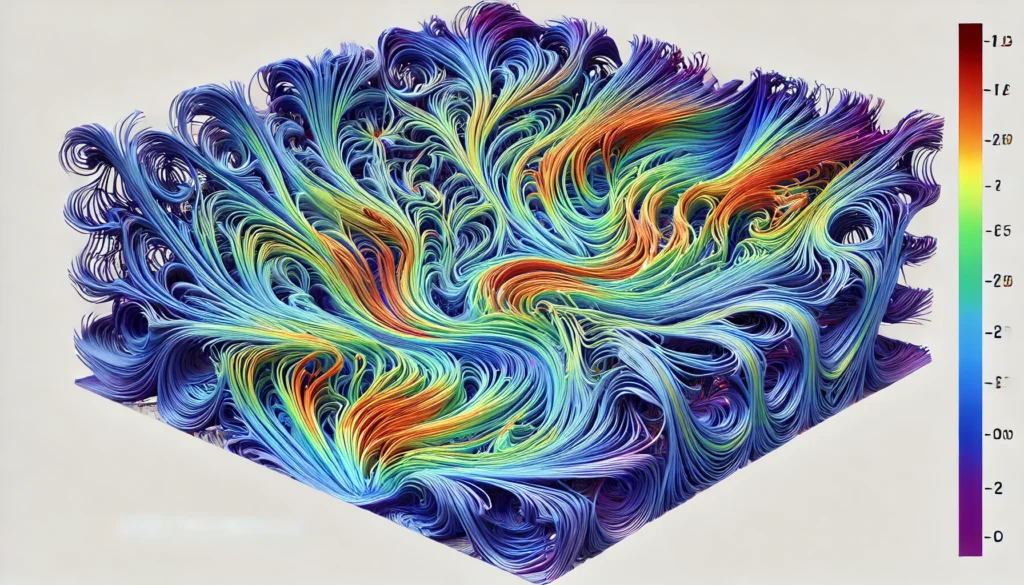Hydrodynamic modeling is a fundamental aspect of ocean engineering, providing crucial insights into the behavior of water bodies and their interaction with various structures. This field of study employs mathematical and computational techniques to simulate the flow of fluids, particularly water, under the influence of various forces. The primary aim is to predict and analyze the movement and properties of water to inform the design, construction, and maintenance of marine and coastal structures. This blog delves deep into the intricacies of hydrodynamic modeling, exploring its principles, methodologies, applications, and recent advancements.
Principles of Hydrodynamic Modeling
At its core, hydrodynamic modeling involves the application of the principles of fluid dynamics to simulate water movement. The fundamental equations governing fluid flow are the Navier-Stokes equations, which describe the motion of viscous fluid substances. These equations account for various forces acting on the fluid, including pressure, viscous, and external forces such as gravity.
The Navier-Stokes equations are expressed as:

Methodologies in Hydrodynamic Modeling
1. Analytical Methods
Analytical methods involve solving the governing equations directly for simplified cases with exact solutions. These methods are primarily used for fundamental studies and validation of more complex numerical models. Solutions are typically obtained for idealized scenarios such as laminar flow in simple geometries. Examples include potential flow theory and linear wave theory.
2. Numerical Methods
Numerical methods are indispensable for solving the Navier-Stokes equations for complex real-world problems. These methods discretize the equations using techniques such as finite difference, finite element, or finite volume methods. The choice of method depends on the specific problem and desired accuracy. Key numerical methods include:
- Finite Difference Method (FDM): Involves approximating derivatives using difference equations.
- Finite Element Method (FEM): Uses variational principles to convert the governing equations into a set of algebraic equations.
- Finite Volume Method (FVM): Conserves quantities by integrating over control volumes.
3. Computational Fluid Dynamics (CFD)

CFD is a branch of fluid mechanics that uses numerical methods and algorithms to solve and analyze fluid flow problems. CFD software, such as ANSYS Fluent, OpenFOAM, and STAR-CCM+, provides powerful tools for hydrodynamic modeling. These tools enable the simulation of complex interactions between fluids and structures, including turbulent flows, free surface flows, and multiphase flows.
Applications of Hydrodynamic Modeling
1. Coastal Engineering
In coastal engineering, hydrodynamic models are used to simulate wave propagation, sediment transport, and shoreline erosion. These models help design coastal protection structures, such as breakwaters, seawalls, and groins. By predicting wave heights and currents, engineers can mitigate the impact of storms and prevent coastal flooding.
2. Offshore Engineering
Offshore engineering relies heavily on hydrodynamic modeling to design and analyze offshore structures like oil platforms, wind turbines, and underwater pipelines. Models simulate the dynamic response of these structures to waves, currents, and wind, ensuring their stability and structural integrity.
3. Environmental Impact Assessment
Hydrodynamic modeling plays a crucial role in assessing the environmental impact of marine and coastal projects. Models can predict the dispersion of pollutants, the impact of dredging activities, and the behavior of oil spills. This information is vital for developing mitigation strategies and complying with environmental regulations.
4. Harbor and Port Design
Designing efficient and safe harbors and ports requires accurate hydrodynamic modeling to understand wave agitation, sedimentation, and current patterns. These models inform the layout of berths, navigation channels, and breakwaters to optimize operations and ensure the safety of vessels.
Advanced Topics in Hydrodynamic Modeling

1. Turbulence Modeling
Turbulence is a complex phenomenon characterized by chaotic fluid motion. Accurate turbulence modeling is essential for predicting flow behavior in various applications. Common approaches include:
- Reynolds-Averaged Navier-Stokes (RANS): This approach averages the effects of turbulence, providing a balance between accuracy and computational efficiency. Popular RANS models include the k-ε and k-ω models.
- Large Eddy Simulation (LES): LES resolves large turbulent structures while modeling smaller scales, offering greater accuracy at higher computational costs.
- Direct Numerical Simulation (DNS): DNS resolves all turbulent scales without any modeling, providing the highest accuracy but requiring significant computational resources.
2. Free Surface Modeling
Free surface modeling is crucial for simulating flows with a distinct interface between fluids, such as air and water. Techniques include:
- Volume of Fluid (VOF): Tracks the volume fraction of each fluid within a computational cell.
- Level Set Method: Uses a continuous function to represent the interface, offering accurate interface tracking.
3. Multiphase Flow Modeling
Multiphase flow modeling addresses the interaction between different fluid phases, such as water, oil, and gas. This is essential for applications like oil spill modeling, underwater plumes, and gas pipeline transport. Approaches include:
- Eulerian-Eulerian Models: Treat each phase as an interpenetrating continuum.
- Eulerian-Lagrangian Models: Track one phase using a Lagrangian approach while treating others as continua.
4. Coupled Models
Hydrodynamic models often need to be coupled with other models to capture the full range of interactions in marine environments. Examples include:
- Wave-Structure Interaction Models: Simulate the effect of waves on offshore structures.
- Hydro-morphodynamic Models: Couple hydrodynamics with sediment transport and morphological changes.
- Biogeochemical Models: Integrate hydrodynamics with biological and chemical processes in water bodies.
Case Study: Hydrodynamic Modeling for Coastal Protection

Problem Definition
Consider a coastal region prone to severe erosion and flooding during storms. The objective is to design a coastal protection scheme that mitigates these issues while preserving the natural environment.
Model Setup
- Domain and Mesh: Define the computational domain covering the coastal region, extending offshore to capture wave generation and propagation. Create a high-resolution mesh near the coast and areas of interest.
- Boundary Conditions: Apply appropriate boundary conditions, such as wave spectra at the offshore boundary, tidal elevations, and land boundaries.
- Governing Equations: Solve the Navier-Stokes equations, incorporating wave and current interactions. Use a suitable turbulence model, such as k-ε, for nearshore turbulence effects.
- Sediment Transport: Implement a sediment transport model to predict erosion and deposition patterns. Use empirical formulas or advanced models like the Exner equation.
Simulation and Analysis
- Wave Propagation: Simulate wave propagation from deep water to the shoreline, capturing wave shoaling, refraction, and breaking.
- Current Patterns: Analyze current patterns generated by tides and waves, identifying regions of strong currents and potential sediment transport.
- Sediment Dynamics: Predict sediment transport and deposition patterns, identifying erosion hotspots and areas of accretion.
- Design Evaluation: Evaluate the effectiveness of different coastal protection measures, such as breakwaters, groins, and beach nourishment. Optimize the design to achieve desired protection levels with minimal environmental impact.
Results
The hydrodynamic model provides detailed insights into wave and current behavior, sediment transport, and coastal morphology. Key findings include:
- Identification of critical erosion areas and potential failure points.
- Optimal placement and design of coastal protection structures.
- Prediction of long-term morphological changes and maintenance requirements.
Recent Advancements in Hydrodynamic Modeling
1. High-Performance Computing (HPC)
Advancements in HPC have significantly enhanced the capabilities of hydrodynamic modeling. Large-scale simulations that were previously infeasible can now be conducted, providing higher resolution and more accurate results. Parallel computing and GPU acceleration further expedite complex simulations.
2. Machine Learning and AI
Machine learning (ML) and artificial intelligence (AI) are increasingly being integrated into hydrodynamic modeling. ML algorithms can optimize model parameters, identify patterns in large datasets, and even predict fluid behavior. AI-driven models can enhance accuracy and reduce computational costs.
3. Data Assimilation
Data assimilation techniques combine observational data with model predictions to improve accuracy. Methods such as the Kalman filter and ensemble methods integrate real-time data, providing more reliable forecasts and reducing uncertainties.
4. Open-Source Software
The development and widespread adoption of open-source CFD software, such as OpenFOAM, have democratized hydrodynamic modeling. These tools offer flexibility, customization, and community support, enabling researchers and engineers to tackle complex problems without proprietary software constraints.
Conclusion
Hydrodynamic modeling is an indispensable tool in ocean engineering, providing detailed insights into fluid behavior and its interaction with structures. Through a combination of analytical, numerical, and computational methods, engineers can design and optimize marine and coastal projects, ensuring safety, efficiency, and environmental sustainability. The field continues to evolve with advancements in HPC, AI, and open-source software, promising even greater accuracy and capabilities in the future.
As the challenges facing our oceans and coasts grow, hydrodynamic modeling will remain at the forefront of engineering solutions, guiding the development of resilient and sustainable marine infrastructure.











